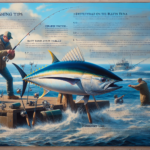Fishing Tips on How to Catch Bluefin Tuna

Introduction
Bluefin tuna, one of the most prized catches in the world of sport and recreational fishing, is renowned for its size, strength, and speed. These magnificent fish are not only a challenge to catch but also a thrill for any angler. This article aims to provide comprehensive tips and techniques for catching bluefin tuna, covering everything from the best times and locations to the recommended gear and common mistakes to avoid.
Fish Species Overview
Description
Bluefin tuna are easily recognizable by their streamlined bodies, metallic blue backs, and silver bellies. They can grow to impressive sizes, with some individuals reaching up to 1,500 pounds and lengths of over 10 feet. Their powerful, torpedo-shaped bodies are built for speed, making them formidable opponents for any angler.
Habitat
Bluefin tuna are primarily found in saltwater environments, particularly in the Atlantic and Pacific Oceans. They prefer temperate and tropical waters and are often found in regions such as the Mediterranean Sea, the Gulf of Mexico, and the waters off the coast of Japan. These fish are highly migratory, traveling vast distances across the ocean.
Behavior
Bluefin tuna are apex predators with voracious appetites. They primarily feed on smaller fish, squid, and crustaceans. Their feeding habits are influenced by the availability of prey, and they often follow schools of baitfish. Spawning typically occurs in warmer waters during the spring and summer months. Bluefin tuna are most active during dawn and dusk, making these times ideal for fishing.
Challenges
Anglers targeting bluefin tuna face several challenges, including their immense strength and speed, which can make them difficult to reel in. Additionally, their migratory nature means that finding them can be a challenge. The use of appropriate gear and techniques is crucial for a successful catch.
Best Time to Catch Bluefin Tuna
Seasonal Considerations
The best time to catch bluefin tuna varies depending on the region. In the Atlantic, the peak season is typically from June to October, while in the Pacific, it can range from May to September. Understanding the migratory patterns of bluefin tuna in your specific location is key to planning a successful fishing trip.
Time of Day
Bluefin tuna are most active during the early morning and late afternoon. These times coincide with their feeding periods, increasing the likelihood of a successful catch. Night fishing can also be productive, especially during a full moon when the fish are more active.
Weather Conditions
Calm, overcast days are ideal for bluefin tuna fishing. These conditions reduce glare on the water, making it easier to spot schools of fish. Additionally, bluefin tuna are more likely to come closer to the surface on cloudy days, increasing your chances of a catch.
Top Fishing Techniques for Bluefin Tuna
Technique 1: Trolling
Trolling is one of the most effective techniques for catching bluefin tuna. This involves dragging lures or baited lines behind a moving boat. The movement mimics the natural swimming action of prey, attracting the attention of bluefin tuna. Using a variety of lures, such as skirted lures, diving plugs, and surface poppers, can increase your chances of success.
Technique 2: Chunking
Chunking involves cutting baitfish into small pieces and throwing them into the water to create a chum line. This technique attracts bluefin tuna to your fishing area, where you can then present a baited hook. Fresh bait, such as mackerel or herring, is most effective for chunking.
Technique 3: Jigging
Jigging is a technique that involves dropping a weighted lure to the desired depth and then rapidly jerking it up and down to mimic the movement of a distressed fish. This can be particularly effective when bluefin tuna are feeding at deeper depths. Metal jigs and butterfly jigs are popular choices for this technique.
Pro Tips
- Use a variety of lures: Bluefin tuna can be unpredictable, so having a range of lures and baits can increase your chances of success.
- Pay attention to water temperature: Bluefin tuna prefer water temperatures between 60-70°F. Use a fish finder to locate areas with optimal temperatures.
- Be patient: Bluefin tuna fishing can require long hours of waiting. Stay alert and be ready to act quickly when you spot a school of fish.
Recommended Gear for Catching Bluefin Tuna
Fishing Rod and Reel
For bluefin tuna, a heavy-duty rod and reel are essential. A stand-up rod with a length of 5.5 to 6.5 feet is ideal for battling these powerful fish. Reels should have a high line capacity and a strong drag system. Lever drag reels are a popular choice among experienced anglers.
Fishing Line
Braided line with a strength of 80-130 pounds is recommended for bluefin tuna fishing. Braided line offers high strength and low stretch, allowing for better control and sensitivity. A fluorocarbon leader of 100-200 pounds can help prevent the fish from seeing the line and increase your chances of a successful catch.
Hooks and Baits
Circle hooks in sizes 8/0 to 12/0 are commonly used for bluefin tuna. These hooks are designed to reduce the chances of gut-hooking the fish, making them more suitable for catch and release. Live bait, such as mackerel, herring, and squid, is highly effective. Artificial lures, such as poppers, jigs, and trolling lures, can also be used.
Additional Gear
- Gaff: A gaff is essential for safely landing large bluefin tuna.
- Fighting belt and harness: These provide additional support and reduce fatigue during long battles with the fish.
- Fish finder: A fish finder can help locate schools of bluefin tuna and identify optimal fishing depths.
Best Locations to Find Bluefin Tuna
General Locations
Bluefin tuna are typically found in offshore waters, often near underwater structures such as seamounts, canyons, and continental shelves. These areas provide abundant food sources and attract schools of baitfish, making them prime hunting grounds for bluefin tuna.
Specific Regions
- Atlantic Ocean: The waters off the coast of New England, the Mid-Atlantic states, and the Gulf of Mexico are known for bluefin tuna fishing.
- Pacific Ocean: The waters off the coast of California, Mexico, and Japan are popular bluefin tuna fishing spots.
- Mediterranean Sea: The Mediterranean is a renowned bluefin tuna fishing region, particularly around Italy, Spain, and Greece.
Common Mistakes to Avoid
Mistake 1: Using Inadequate Gear
Bluefin tuna are incredibly strong and can easily break weak or inadequate gear. Ensure you use heavy-duty rods, reels, and lines designed for big game fishing.
Mistake 2: Ignoring Water Temperature
Bluefin tuna prefer specific water temperatures. Ignoring this factor can result in wasted time and effort. Use a fish finder to locate areas with optimal temperatures.
Mistake 3: Lack of Patience
Bluefin tuna fishing can require long hours of waiting. Impatience can lead to missed opportunities. Stay alert and be prepared to act quickly when you spot a school of fish.
Catch and Release Tips
Importance of Conservation
Bluefin tuna populations have been significantly impacted by overfishing. Practicing catch and release helps ensure the sustainability of this species for future generations. Ethical fishing practices are crucial for conservation efforts.
Proper Handling Techniques
- Use circle hooks: These reduce the chances of gut-hooking the fish, increasing its chances of survival after release.
- Avoid lifting the fish by the gills: This can cause serious injury. Instead, support the fish’s body when handling it.
- Minimize handling time: The less time the fish spends out of the water, the better its chances of survival.
Legal Considerations
Be aware of local regulations regarding bluefin tuna fishing. This includes size limits, bag limits, and any protected areas where fishing is prohibited. Always adhere to these regulations to ensure sustainable fishing practices.
Frequently Asked Questions (FAQs)
What is the best bait for catching bluefin tuna?
The best bait for bluefin tuna includes live bait such as mackerel, herring, and squid. These baits mimic the natural prey of bluefin tuna and are highly effective. Artificial lures, such as poppers, jigs, and trolling lures, can also be used successfully.
Where is the best place to fish for bluefin tuna?
Bluefin tuna are commonly found in offshore waters near underwater structures such as seamounts, canyons, and continental shelves. Popular fishing spots include the waters off the coast of New England, the Mid-Atlantic states, California, Mexico, Japan, and the Mediterranean Sea.
What time of day is best for catching bluefin tuna?
The best times to catch bluefin tuna are during the early morning and late afternoon. These periods coincide with their feeding times, increasing the likelihood of a successful catch. Night fishing can also be productive, especially during a full moon.
What type of fishing line should I use for bluefin tuna?
Braided line with a strength of 80-130 pounds is recommended for bluefin tuna fishing. Braided line offers high strength and low stretch, allowing for better control and sensitivity. A fluorocarbon leader of 100-200 pounds can help prevent the fish from seeing the line.
Do I need a special fishing license to catch bluefin tuna?
Yes, a special fishing license is often required to catch bluefin tuna. Licensing requirements vary by region, so it’s important to check local regulations. This may include size limits, bag limits, and any special permits needed.
What is the best technique for catching bluefin tuna?
Trolling, chunking, and jigging are among the most effective techniques for catching bluefin tuna. Trolling involves dragging lures or baited lines behind a moving boat, while chunking uses cut bait to create a chum line. Jigging involves rapidly jerking a weighted lure to mimic a distressed fish.
Are there any specific weather conditions that improve the chances of catching bluefin tuna?
Calm, overcast days are ideal for bluefin tuna fishing. These conditions reduce glare on the water and make it easier to spot schools of fish. Bluefin tuna are also more likely to come closer to the surface on cloudy days.
Can I catch bluefin tuna from the shore, or do I need a boat?
Bluefin tuna are typically found in offshore waters, so a boat is usually necessary for successful fishing. However, in some regions, such as certain parts of the Mediterranean, it may be possible to catch bluefin tuna from the shore during their spawning season.
How can I improve my chances of landing a big bluefin tuna?
To improve your chances of landing a big bluefin tuna, use heavy-duty gear, pay attention to water temperature, and fish during their peak feeding times. Using live bait and a variety of lures can also increase your chances of success.
What should I do if I plan to release bluefin tuna after catching them?
If you plan to release bluefin tuna, use circle hooks to reduce the chances of gut-hooking the fish. Avoid lifting the fish by the gills and minimize handling time. Support the fish’s body when handling it and release it as quickly as possible to ensure its survival.
Conclusion
Catching bluefin tuna is a thrilling and rewarding experience for any angler. By understanding their behavior, using the right gear and techniques, and practicing ethical fishing practices, you can increase your chances of a successful catch. Remember to be patient, stay alert, and enjoy the challenge of reeling in one of the ocean’s most powerful predators. Happy fishing!




